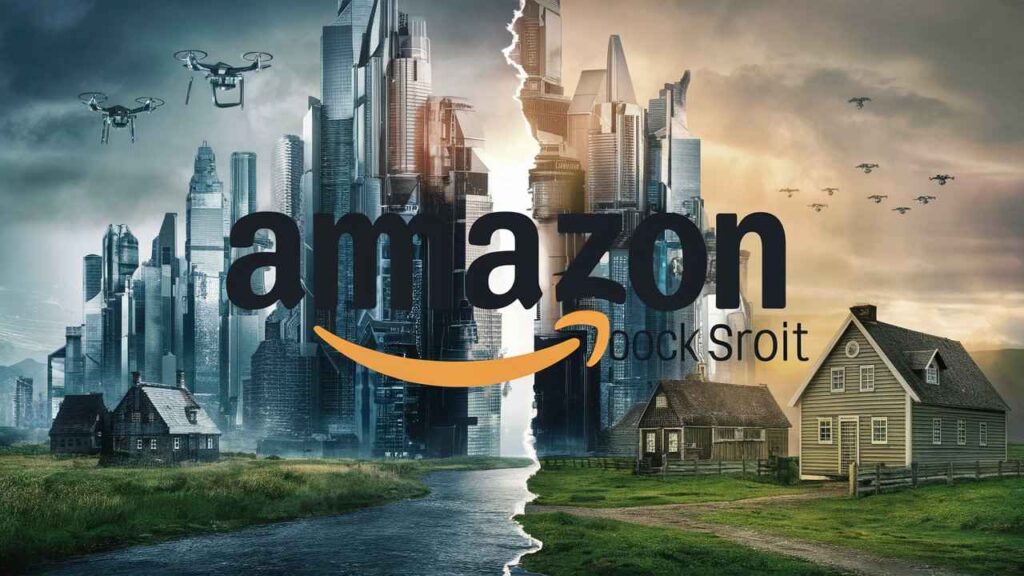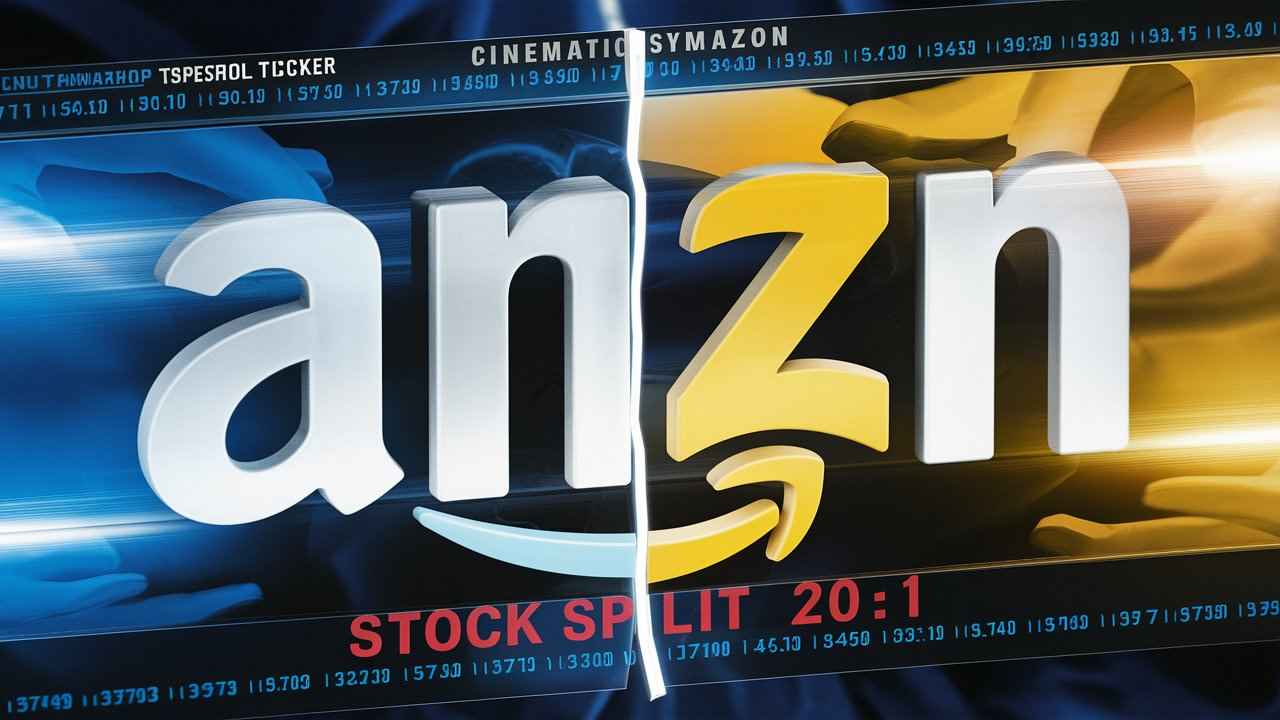What’s the Deal with Stock Splits?
A stock split is like that magical moment when you cut a pizza into more slices💲it doesn’t give you extra toppings, but it does make the pizza seem more shareable. In the financial world, a stock split divides a company’s existing shares into multiple new shares, often making each share more affordable for individual investors. When companies split their stocks, they’re not changing the overall value of the pie; they’re just slicing it in ways that make it easier for everyone to grab a piece.

Why Big Companies Love to Slice Up Their Shares
Big names like Apple, Tesla, and now Amazon have made stock splits almost a rite of passage. These companies enjoy the liquidity and accessibility that stock splits bring, broadening their investor base by lowering the per-share price. A lower price point per share can spark excitement, bringing in fresh retail investors who couldn’t previously afford the high share price. Ultimately, a stock split can improve market sentiment, attract new investors, and boost trading volumes💲all without changing the company’s intrinsic value.
Amazon’s Big Move: Why Did Amazon Split Its Stock?
When Amazon announced its long-awaited split, investors everywhere tuned in. But why? Amazon’s split wasn’t just a flashy move; it was a strategic decision designed to make its stock more appealing to the everyday investor. In May 2022, Amazon underwent a massive 20-for-1 Amazon stock split, reducing its hefty four-digit share price to a more wallet-friendly figure. This split made Amazon shares accessible to a wider audience while aiming to boost trading activity and align its strategy with other tech giants that have successfully split.💲

What Exactly Is an Amazon Stock Split?
Stock Splits 101: The Basics Explained
A stock split doesn’t create any extra value; it merely divides the shares, multiplying their number while reducing the per-share price. For Amazon, the split ratio was 20-for-1. That means each pre-split share was converted into 20 new shares, with each new share priced at about 1/20th of its pre-split value. The total market capitalization? Unchanged. The math behind a stock split is elementary, but its effect on stock accessibility and investor enthusiasm can be profound.💲
Breaking Down a 20-for-1 Split: Why This Ratio?
Amazon’s 20-for-1 split may seem a bit extreme compared to more conservative 2-for-1 or 3-for-1 splits, but the logic here is clear. With a share price that once soared above $3,000, a 20-for-1 split brought the stock price down to around $150. This ratio lowered Amazon’s share price enough to make a substantial difference in accessibility, opening the door to smaller investors who previously found Amazon’s price intimidating.
How Many Shares Do You Really Get?
Post-split, every Amazon shareholder received 20 shares for each share they owned. If you held one share worth $3,000 before, you now own 20 shares valued at about $150 each. Your total investment remains the same, but you’ve multiplied your shares, effectively democratizing Amazon’s ownership.💲

Why Did Amazon Choose to Split Its Stock?
Accessibility for All: Making Amazon More Affordable
One of the primary reasons behind the Amazon stock split was to democratize access. High share prices can alienate smaller investors, so lowering the price per share makes it more attractive for everyday investors. Amazon followed the lead of other tech giants by making their shares easier to buy, hoping to lure a broader base of retail investors.💲
Strategic Growth: How This Split Could Attract More Investors
By lowering its share price, Amazon’s split could attract younger, newer investors who prefer to buy whole shares rather than fractions. The psychology of owning “20 shares of Amazon” at a lower price might entice those who avoided Amazon at higher levels. Additionally, increased retail participation can add to liquidity, further bolstering Amazon’s appeal and growth potential.
Keeping Up with the Joneses (or Teslas): Following Tech Giants
Following in the footsteps of companies like Tesla and Apple, Amazon’s stock split also keeps it competitive within the tech space. High prices can lead to comparisons that work against a company’s accessibility and brand. By aligning its stock price with those of other tech heavyweights, Amazon sends a message that it’s adaptable and investor-friendly.

The Timing: When Did Amazon’s Stock Split Happen?
Important Dates to Know for Amazon Investors
Amazon announced the split in March 2022, and the actual Amazon stock split took effect on June 6, 2022. This was a big day for investors who’d been eyeing the company but couldn’t stomach the pre-split price tag. The announcement date is crucial since it often triggers initial excitement, while the effective date is when investors see the split reflected in their accounts.💲
How Long Does It Take for a Stock Split to Show Up?
After the split takes effect, brokerage accounts typically adjust to reflect the new share count within a few days. However, the date of the split and the date investors actually see the adjusted price can sometimes vary depending on the brokerage.

What Does the Split Mean for Shareholders?
Did My Investment Shrink? Spoiler Alert: Nope!
A stock split doesn’t alter the total value of your investment💲it simply changes the number of shares and the per-share price. If you owned one $3,000 share before, you now hold 20 shares worth around $150 each. Your investment size remains the same, but your portfolio has become a bit more “shareful.”
New Shares, Same Value: What the Split Means for Portfolio Balances
Despite the new share count, Amazon’s market capitalization remains the same. That’s the beauty of stock splits: they affect the share price but not the company’s actual value. Shareholders experience no loss, just a new math equation for their portfolio.
Fractional Shares: Are They Affected by Amazon’s Split?
If you owned fractional shares of Amazon pre-split, your holdings were adjusted accordingly. Brokers typically recalibrate fractional shares to match the split, so your investment stays proportionate to the pre-split share value.💲

Stock Splits vs. Reverse Splits: What’s the Difference?
Forward vs. Reverse: When Splits Go Both Ways
A forward stock split, like Amazon’s, multiplies shares and reduces the price per share, making stocks more accessible. Conversely, a reverse split consolidates shares, reducing their count and raising the price per share, often done to satisfy listing requirements or bolster an image of stability.💲
Why Companies Choose One Split Type Over the Other
Forward splits are all about accessibility, while reverse splits are often used to maintain compliance on stock exchanges. Companies in financial trouble might opt for a reverse split to boost their per-share price and remain listed on major exchanges.
Can a Reverse Split Happen to Amazon in the Future?
Unlikely. Given Amazon’s strong market position and financial health, a reverse split isn’t on the horizon. However, if the market changes drastically, companies can reevaluate their stock structure.
How Do Stock Splits Impact Stock Prices?
Does a Split Make Amazon Stock Cheaper?
Yes and no. A stock split makes each share cheaper, but it doesn’t necessarily make the stock a “bargain.” A split merely adjusts the price to reflect more shares without affecting Amazon’s market cap.💲
Will Amazon’s Split Drive Demand and Boost Prices?
There’s often a bump in demand following a split as more retail investors hop on board. While a stock split alone doesn’t guarantee price growth, it can stimulate trading and investor interest, which can lead to price appreciation over time.
How Long Before We See the Effects?
The effects of a stock split can manifest quickly in trading volume but may take longer to influence the stock price. Some companies experience a post-split rally, while others maintain stability.
The Psychology of a Stock Split: Why Perception Matters
Investors and Lower Prices: The Appeal of Splits
Psychologically, investors may find a lower-priced stock more attractive, even if the company’s value hasn’t changed. Lower prices can convey accessibility, potentially leading to a higher level of investor engagement.💲
The Big Impact of Small Shares in the Market
For some, owning multiple shares instead of a fraction can be satisfying and empowering. This increased accessibility can create a ripple effect, driving up trading volume and sparking new interest.
How Stock Splits Play on Market Sentiment
Market sentiment can be buoyed by a stock split as investors interpret the move as a sign of confidence. Companies usually split stocks when they’re performing well, feeding the narrative that the company is on a stable growth trajectory.
Amazon’s Stock Split vs. Its Peers
Comparing Amazon’s Split with Apple, Tesla, and Google
Apple and Tesla have both implemented stock splits in recent years, with positive results in terms of trading volume and accessibility. Comparing Amazon’s 20-for-1 split with others shows a significant move in terms of the sheer reduction in share price.💲
Lessons from Other Tech Giants Who’ve Split Before
Amazon’s peers in the tech space have demonstrated that stock splits can enhance trading activity and attract retail investors without any impact on company fundamentals. This can boost a stock’s visibility, making it a popular move for tech giants.
What History Says: Do Stock Splits Lead to Gains?
Historically, companies that split their stocks often experience increased liquidity and interest. While it’s no guarantee of gains, history suggests that splits have positive effects on long-term performance.
Conclusion: What Amazon’s Stock Split Means for the Future
Amazon’s Next Steps After the Split
Amazon’s split represents a new chapter, opening up ownership to a larger audience. Future moves will determine if the split was just a strategyfor accessibility or a foundation for further growth.💲
How This Move Reflects Amazon’s Strategy
Amazon’s stock split is a strategic decision to remain attractive in a competitive market, potentially positioning it for broader growth by connecting with new retail investors.
Why Amazon’s Stock Split is Big News for Investors
Amazon’s split reflects confidence in its future and an invitation to more investors to join the journey. While it doesn’t alter the company’s value, it signals a shift toward inclusivity, making Amazon stock one of the most accessible tech giants for a broader investor base.
People Also Ask
Is Amazon Going to Split in 2024?
As of now, Amazon has not announced any plans to conduct another stock split in 2024. However, large tech companies like Amazon monitor market conditions and may choose to split their stock again if it aligns with their strategic goals.💲
What Stocks Will Split in 2024?
Companies occasionally announce stock splits as part of their growth strategies. To find specific stocks expected to split in 2024, investors can watch for announcements from tech giants, growth companies, and other high-performing firms in sectors like technology and finance.
What is a 20-to-1 Split?
A 20-to-1 split means that for every single share held by an investor, they would receive 20 new shares after the split. For example, Amazon’s 2022 split converted each share into 20 shares, reducing the individual share price while keeping the overall investment value the same.
Has Amazon Stock Ever Been $2000?
Yes, Amazon stock surpassed the $2,000 mark in 2018. Before its split in 2022, Amazon’s share price reached a high point, trading in the thousands, which was one of the motivations behind the stock split to make it more affordable.💲
Is it Better to Buy Before or After a Stock Split?
While there’s no one-size-fits-all answer, buying either before or after a split can be beneficial depending on your strategy. Buying before a split can capitalize on increased demand and potential gains, while purchasing after a split offers a more accessible price point for new investors.
How Much Will Amazon Go Up After a Stock Split?
A stock split does not guarantee price increases; however, Amazon’s post-split performance can benefit from increased trading volume and new investor interest, which sometimes leads to gradual price appreciation over time.
What Will Amazon Stock Be Worth in 2025?
Predicting Amazon’s stock price for 2025 involves considering market trends, sector growth, and Amazon’s own performance. Analysts anticipate continued growth, but specific values are speculative and depend on market conditions.💲
What Was Amazon’s Highest Stock Price?
Amazon’s highest stock price was around $3,773 before its 2022 20-for-1 stock split. After the split, the adjusted price made shares more accessible, but the pre-split peak remains a notable record.
What Happens When a Stock Splits?
When a stock splits, shareholders receive additional shares in proportion to the split ratio, and the per-share price is adjusted accordingly. For example, a 2-for-1 split would double the number of shares and halve the price, maintaining the total investment value.
Do Stocks Go Up After a Split?
A stock split doesn’t automatically increase a stock’s price, but it often attracts new investors, increasing demand and potentially driving up the price over time due to heightened trading volume and market interest.
How Big Will Amazon Be in 2030?
By 2030, Amazon is projected to be an even larger player in e-commerce, cloud computing, and various new technology ventures. Its growth will depend on market expansion, innovation, and adapting to evolving customer needs.💲
How High Will Amazon Stock Go in 2024?
Predictions for Amazon’s 2024 stock performance vary, with analysts considering growth in Amazon Web Services (AWS), retail operations, and emerging tech investments. The stock could continue to rise if these sectors expand.
Will Tesla Split Again in 2024?
Tesla has already split its stock twice in recent years, but there’s no official announcement for another split in 2024. However, given Tesla’s history, a future split remains possible if it aligns with their market strategies.
What Will Amazon Price Be in 2024?
Amazon’s 2024 stock price will depend on various factors, including economic conditions, company performance, and investor sentiment. Analysts provide estimates, but precise predictions are uncertain.
Has Tesla Stock Ever Split?
Yes, Tesla has split its stock twice💲in 2020 and 2022💲to make shares more accessible and encourage retail investment, following the lead of companies like Amazon and Apple.
Should I Buy Before a Stock Split?
Buying before a split can provide access to the pre-split share price and potential gains as new investors are drawn in post-split. However, investors should assess the stock’s long-term potential before deciding.
Will Google Split in 2024?
Currently, there is no announcement for a Google stock split in 2024. However, major companies often reassess their stock strategies, so investors may hear more on this in the future.
What is the Future of Amazon Stock?
Amazon’s stock future appears robust with growth across its e-commerce, cloud computing, and digital service segments. The company’s continuous innovation and global expansion make it a strong contender in the market for years to come.
Which Stock to Buy for the Next 5 Years?
Growth stocks in sectors like technology, green energy, and healthcare have long-term potential. Companies with strong fundamentals, high innovation capacity, and proven market demand are prime candidates for five-year investments.
Which Stock is Best for 2025?
The best stock for 2025 will likely come from sectors showing steady growth, like technology, biotech, and green energy. Amazon, Microsoft, and emerging AI companies are on many analysts’ radars as solid 2025 candidates.








